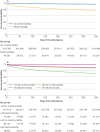Multimorbidity and adverse outcomes following emergency department attendance: population based cohort study
- PMID: 39184567
- PMCID: PMC11344864
- DOI: 10.1136/bmjmed-2023-000731
Multimorbidity and adverse outcomes following emergency department attendance: population based cohort study
Abstract
Objectives: To describe the effect of multimorbidity on adverse patient centred outcomes in people attending emergency department.
Design: Population based cohort study.
Setting: Emergency departments in NHS Lothian in Scotland, from 1 January 2012 to 31 December 2019.
Participants: Adults (≥18 years) attending emergency departments.
Data sources: Linked data from emergency departments, hospital discharges, and cancer registries, and national mortality data.
Main outcome measures: Multimorbidity was defined as at least two conditions from the Elixhauser comorbidity index. Multivariable logistic or linear regression was used to assess associations of multimorbidity with 30 day mortality (primary outcome), hospital admission, reattendance at the emergency department within seven days, and time spent in emergency department (secondary outcomes). Primary analysis was stratified by age (<65 v ≥65 years).
Results: 451 291 people had 1 273 937 attendances to emergency departments during the study period. 43 504 (9.6%) had multimorbidity, and people with multimorbidity were older (median 73 v 43 years), more likely to arrive by emergency ambulance (57.8% v 23.7%), and more likely to be triaged as very urgent (23.5% v 9.2%) than people who do not have multimorbidity. After adjusting for other prognostic covariates, multimorbidity, compared with no multimorbidity, was associated with higher 30 day mortality (8.2% v 1.2%, adjusted odds ratio 1.81 (95% confidence interval (CI) 1.72 to 1.91)), higher rate of hospital admission (60.1% v 20.5%, 1.81 (1.76 to 1.86)), higher reattendance to an emergency department within seven days (7.8% v 3.5%, 1.41 (1.32 to 1.50)), and longer time spent in the department (adjusted coefficient 0.27 h (95% CI 0.26 to 0.27)). The size of associations between multimorbidity and all outcomes were larger in younger patients: for example, the adjusted odds ratio of 30 day mortality was 3.03 (95% CI 2.68 to 3.42) in people younger than 65 years versus 1.61 (95% CI 1.53 to 1.71) in those 65 years or older.
Conclusions: Almost one in ten patients presenting to emergency department had multimorbidity using Elixhauser index conditions. Multimorbidity was strongly associated with adverse outcomes and these associations were stronger in younger people. The increasing prevalence of multimorbidity in the population is likely to exacerbate strain on emergency departments unless practice and policy evolve to meet the growing demand.
Keywords: Emergency medicine; Epidemiology.
Copyright © Author(s) (or their employer(s)) 2024. Re-use permitted under CC BY. Published by BMJ.
Conflict of interest statement
All authors have completed the ICMJE uniform disclosure form at www.icmje.org/disclosure-of-interest/ and declare: NL is supported by Wellcome ISSF3 grant (ref. IS3-R1.05 19/20) for the completion of this work; NLM is supported by a Chair Award, Programme Grant, and Research Excellence Award (CH/F/21/90010, RG/20/10/34966, RE/18/5/34216) from the British Heart Foundation. MR is supported by an NHS Research Scotland Career Researcher Clinician award. NLM has also received payment for lectures by Abbott Diagnostics and Siemens Healthineers, has participated on advisory boards for LumiraDx, Roche Diagnostics and Siemens Healthineers, and has received equipment from Siemens Healthineers (not related to this project). All other authors declare no support from any organisation for the submitted work; no financial relationships with any organisations that might have an interest in the submitted work in the previous three years; no other relationships or activities that could appear to have influenced the submitted work.
Figures






Comment on
-
Multimorbidity in emergency departments: urgent need for integrated care.BMJ Med. 2024 Aug 16;3(1):e000989. doi: 10.1136/bmjmed-2024-000989. eCollection 2024. BMJ Med. 2024. PMID: 39175922 Free PMC article. No abstract available.
References
-
- Palladino R, Nardone A, Millett C, et al. The impact of Multimorbidity on health outcomes in older adults between 2006 and 2015 in Europe. Eur J Public Health. 2018;28 doi: 10.1093/eurpub/cky212.400. - DOI
Publication types
Grants and funding
LinkOut - more resources
Full Text Sources
